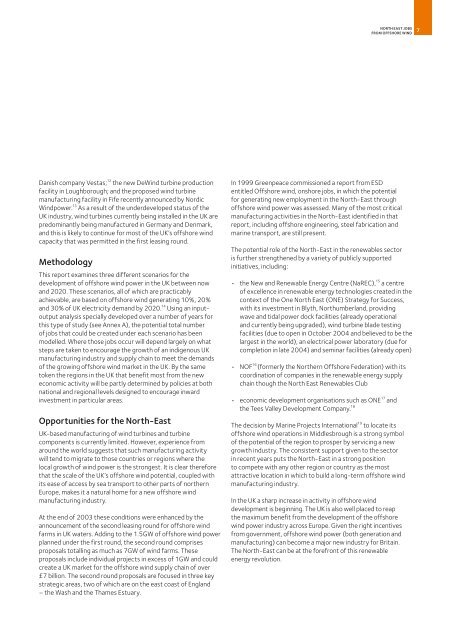offshore wind onshore jobs - a new industry for ... - Greenpeace UK
offshore wind onshore jobs - a new industry for ... - Greenpeace UK
offshore wind onshore jobs - a new industry for ... - Greenpeace UK
Create successful ePaper yourself
Turn your PDF publications into a flip-book with our unique Google optimized e-Paper software.
NORTH EAST JOBS<br />
FROM OFFSHORE WIND<br />
7<br />
Danish company Vestas; 12 the <strong>new</strong> DeWind turbine production<br />
facility in Loughborough; and the proposed <strong>wind</strong> turbine<br />
manufacturing facility in Fife recently announced by Nordic<br />
Windpower. 13 As a result of the underdeveloped status of the<br />
<strong>UK</strong> <strong>industry</strong>, <strong>wind</strong> turbines currently being installed in the <strong>UK</strong> are<br />
predominantly being manufactured in Germany and Denmark,<br />
and this is likely to continue <strong>for</strong> most of the <strong>UK</strong>’s <strong>offshore</strong> <strong>wind</strong><br />
capacity that was permitted in the first leasing round.<br />
Methodology<br />
This report examines three different scenarios <strong>for</strong> the<br />
development of <strong>offshore</strong> <strong>wind</strong> power in the <strong>UK</strong> between now<br />
and 2020. These scenarios, all of which are practicably<br />
achievable, are based on <strong>offshore</strong> <strong>wind</strong> generating 10%, 20%<br />
and 30% of <strong>UK</strong> electricity demand by 2020. 14 Using an inputoutput<br />
analysis specially developed over a number of years <strong>for</strong><br />
this type of study (see Annex A), the potential total number<br />
of <strong>jobs</strong> that could be created under each scenario has been<br />
modelled. Where those <strong>jobs</strong> occur will depend largely on what<br />
steps are taken to encourage the growth of an indigenous <strong>UK</strong><br />
manufacturing <strong>industry</strong> and supply chain to meet the demands<br />
of the growing <strong>offshore</strong> <strong>wind</strong> market in the <strong>UK</strong>. By the same<br />
token the regions in the <strong>UK</strong> that benefit most from the <strong>new</strong><br />
economic activity will be partly determined by policies at both<br />
national and regional levels designed to encourage inward<br />
investment in particular areas.<br />
Opportunities <strong>for</strong> the North-East<br />
<strong>UK</strong>-based manufacturing of <strong>wind</strong> turbines and turbine<br />
components is currently limited. However, experience from<br />
around the world suggests that such manufacturing activity<br />
will tend to migrate to those countries or regions where the<br />
local growth of <strong>wind</strong> power is the strongest. It is clear there<strong>for</strong>e<br />
that the scale of the <strong>UK</strong>’s <strong>offshore</strong> <strong>wind</strong> potential, coupled with<br />
its ease of access by sea transport to other parts of northern<br />
Europe, makes it a natural home <strong>for</strong> a <strong>new</strong> <strong>offshore</strong> <strong>wind</strong><br />
manufacturing <strong>industry</strong>.<br />
At the end of 2003 these conditions were enhanced by the<br />
announcement of the second leasing round <strong>for</strong> <strong>offshore</strong> <strong>wind</strong><br />
farms in <strong>UK</strong> waters. Adding to the 1.5GW of <strong>offshore</strong> <strong>wind</strong> power<br />
planned under the first round, the second round comprises<br />
proposals totalling as much as 7GW of <strong>wind</strong> farms. These<br />
proposals include individual projects in excess of 1GW and could<br />
create a <strong>UK</strong> market <strong>for</strong> the <strong>offshore</strong> <strong>wind</strong> supply chain of over<br />
£7 billion. The second round proposals are focused in three key<br />
strategic areas, two of which are on the east coast of England<br />
– the Wash and the Thames Estuary.<br />
In 1999 <strong>Greenpeace</strong> commissioned a report from ESD<br />
entitled Offshore <strong>wind</strong>, <strong>onshore</strong> <strong>jobs</strong>, in which the potential<br />
<strong>for</strong> generating <strong>new</strong> employment in the North-East through<br />
<strong>offshore</strong> <strong>wind</strong> power was assessed. Many of the most critical<br />
manufacturing activities in the North-East identified in that<br />
report, including <strong>offshore</strong> engineering, steel fabrication and<br />
marine transport, are still present.<br />
The potential role of the North-East in the re<strong>new</strong>ables sector<br />
is further strengthened by a variety of publicly supported<br />
initiatives, including:<br />
• the New and Re<strong>new</strong>able Energy Centre (NaREC), 15 a centre<br />
of excellence in re<strong>new</strong>able energy technologies created in the<br />
context of the One North East (ONE) Strategy <strong>for</strong> Success,<br />
with its investment in Blyth, Northumberland, providing<br />
wave and tidal power dock facilities (already operational<br />
and currently being upgraded), <strong>wind</strong> turbine blade testing<br />
facilities (due to open in October 2004 and believed to be the<br />
largest in the world), an electrical power laboratory (due <strong>for</strong><br />
completion in late 2004) and seminar facilities (already open)<br />
• NOF 16 (<strong>for</strong>merly the Northern Offshore Federation) with its<br />
coordination of companies in the re<strong>new</strong>able energy supply<br />
chain though the North East Re<strong>new</strong>ables Club<br />
• economic development organisations such as ONE 17 and<br />
the Tees Valley Development Company. 18<br />
The decision by Marine Projects International 19 to locate its<br />
<strong>offshore</strong> <strong>wind</strong> operations in Middlesbrough is a strong symbol<br />
of the potential of the region to prosper by servicing a <strong>new</strong><br />
growth <strong>industry</strong>. The consistent support given to the sector<br />
in recent years puts the North-East in a strong position<br />
to compete with any other region or country as the most<br />
attractive location in which to build a long-term <strong>offshore</strong> <strong>wind</strong><br />
manufacturing <strong>industry</strong>.<br />
In the <strong>UK</strong> a sharp increase in activity in <strong>offshore</strong> <strong>wind</strong><br />
development is beginning. The <strong>UK</strong> is also well placed to reap<br />
the maximum benefit from the development of the <strong>offshore</strong><br />
<strong>wind</strong> power <strong>industry</strong> across Europe. Given the right incentives<br />
from government, <strong>offshore</strong> <strong>wind</strong> power (both generation and<br />
manufacturing) can become a major <strong>new</strong> <strong>industry</strong> <strong>for</strong> Britain.<br />
The North-East can be at the <strong>for</strong>efront of this re<strong>new</strong>able<br />
energy revolution.




![[2007] EWHC 311 - Greenpeace UK](https://img.yumpu.com/22079793/1/184x260/2007-ewhc-311-greenpeace-uk.jpg?quality=85)











